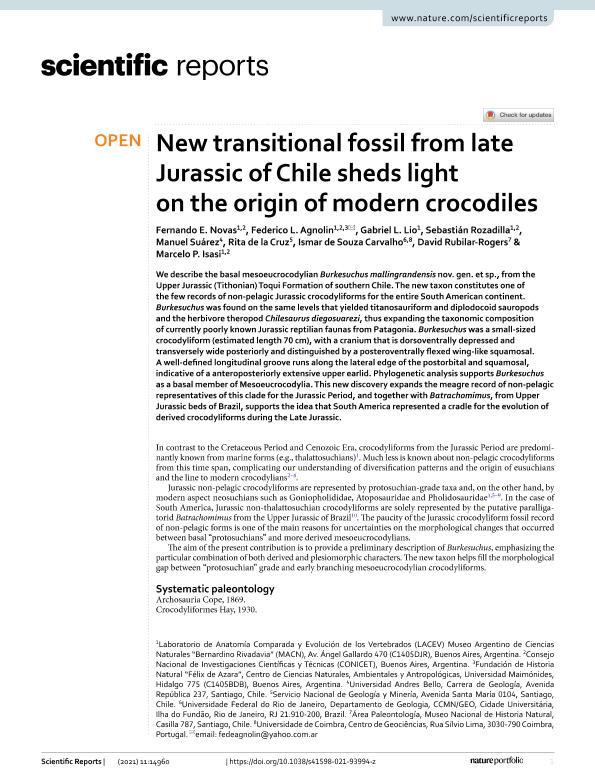Artículo
New transitional fossil from late Jurassic of Chile sheds light on the origin of modern crocodiles
Novas, Fernando Emilio ; Agnolin, Federico
; Agnolin, Federico ; Lio, Gabriel L.; Rozadilla, Sebastian
; Lio, Gabriel L.; Rozadilla, Sebastian ; Suárez, Manuel; de la Cruz, Rita; de Souza Carvalho, Ismar; Rubilar Rogers, David; Isasi, Marcelo Pablo
; Suárez, Manuel; de la Cruz, Rita; de Souza Carvalho, Ismar; Rubilar Rogers, David; Isasi, Marcelo Pablo
 ; Agnolin, Federico
; Agnolin, Federico ; Lio, Gabriel L.; Rozadilla, Sebastian
; Lio, Gabriel L.; Rozadilla, Sebastian ; Suárez, Manuel; de la Cruz, Rita; de Souza Carvalho, Ismar; Rubilar Rogers, David; Isasi, Marcelo Pablo
; Suárez, Manuel; de la Cruz, Rita; de Souza Carvalho, Ismar; Rubilar Rogers, David; Isasi, Marcelo Pablo
Fecha de publicación:
12/2021
Editorial:
Nature Publishing Group
Revista:
Scientific Reports
ISSN:
2045-2322
Idioma:
Inglés
Tipo de recurso:
Artículo publicado
Clasificación temática:
Resumen
We describe the basal mesoeucrocodylian Burkesuchus mallingrandensis nov. gen. et sp., from the Upper Jurassic (Tithonian) Toqui Formation of southern Chile. The new taxon constitutes one of the few records of non-pelagic Jurassic crocodyliforms for the entire South American continent. Burkesuchus was found on the same levels that yielded titanosauriform and diplodocoid sauropods and the herbivore theropod Chilesaurus diegosuarezi, thus expanding the taxonomic composition of currently poorly known Jurassic reptilian faunas from Patagonia. Burkesuchus was a small-sized crocodyliform (estimated length 70 cm), with a cranium that is dorsoventrally depressed and transversely wide posteriorly and distinguished by a posteroventrally flexed wing-like squamosal. A well-defined longitudinal groove runs along the lateral edge of the postorbital and squamosal, indicative of a anteroposteriorly extensive upper earlid. Phylogenetic analysis supports Burkesuchus as a basal member of Mesoeucrocodylia. This new discovery expands the meagre record of non-pelagic representatives of this clade for the Jurassic Period, and together with Batrachomimus, from Upper Jurassic beds of Brazil, supports the idea that South America represented a cradle for the evolution of derived crocodyliforms during the Late Jurassic.
Palabras clave:
Crocodyliformes
,
Jurassic
Archivos asociados
Licencia
Identificadores
Colecciones
Articulos(MACNBR)
Articulos de MUSEO ARG.DE CS.NAT "BERNARDINO RIVADAVIA"
Articulos de MUSEO ARG.DE CS.NAT "BERNARDINO RIVADAVIA"
Citación
Novas, Fernando Emilio; Agnolin, Federico; Lio, Gabriel L.; Rozadilla, Sebastian; Suárez, Manuel; et al.; New transitional fossil from late Jurassic of Chile sheds light on the origin of modern crocodiles; Nature Publishing Group; Scientific Reports; 11; 1; 12-2021; 1-13
Compartir
Altmétricas



